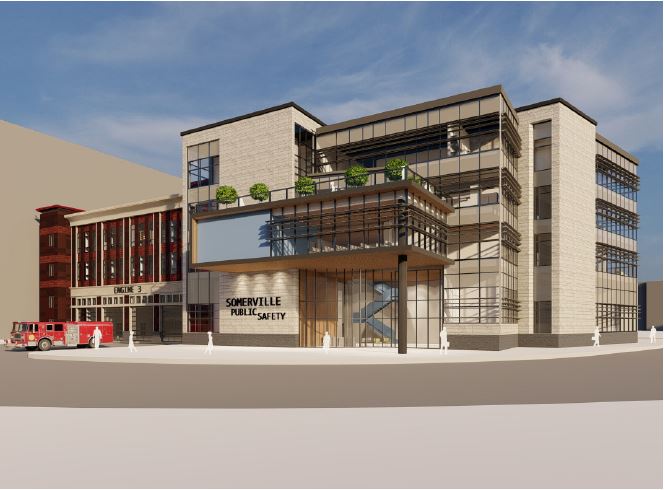An increased police presence does not necessarily make people feel safer
(Somerville Wire) – The City of Somerville, together with the Capital Projects Division of its Department of Infrastructure and Assets Management that oversees construction of all City-owned buildings, is advancing a Public Safety Building project, an idea that has been in discussion for a long time, but that community members feel they have only been engaged with recently. On Feb. 2, the City held a meeting to outline plans and hear from the public, and it was met with active concern from several of the 35 members of the public in attendance. The building is envisioned to be built at 90 Washington Street, and it would be home to police, fire administration, and Engine 3.
Tom Galligani, director of Economic Development, spoke at a December meeting about why the City sees a need for the Public Safety Building, “Our project objectives … are to deliver a modern public safety building that meets the needs of police and fire, but also contributes to the larger city-wide goals,” said Galligani. “We want to develop the entire site; that includes the Public Safety Building and the private development in a cohesive and complimentary way. They need to work together to create a place that makes sense and that supports our goals and community vision.”
Melissa Woods, director of Capital Projects, spoke to what she sees as the value of a new structure in the city, “Building a new public safety building is important for a multitude of reasons. The existing facility at 220 Washington Street is beyond its useful life – it does not meet the needs of the existing tenants or visitors, nor does it help us meet other citywide goals like those in Somerville Climate Forward,” wrote Woods in a statement. “In addition, Engine 3 needs to be relocated to the eastern side of Union Square to maintain response times. The new office building will be a flexible space that meets the needs of Police, Fire, Dispatch, and Emergency Management. As the future of policing conversations unfold, this building will be able to adapt to meet any future needs. The new public safety building will be one part of the redevelopment at 90 Washington Street. People interested should join the community conversation around what other uses and design considerations should be incorporated into the site.”
According to a City site, the Somerville Police Department and Engine 3 had moved into the current public safety facility in the 1980s. Now, the building is “functionally obsolete and requires replacement;” it is “inadequate for current public safety operations and, furthermore, has been plagued with structural issues that have led to flooding and leaks.” The new building will have public and community space, shared space for all departments, emergency management, a new home for the relocating Engine 3, fire administration space, and a police headquarters. There will be room for dispatch for both police and fire departments, a gym, living quarters, family services areas, and detention spaces.
At the Feb. 2 meeting, many community members expressed worry about the establishment of a new Public Safety Building. Emma Rose, a resident who lives in Ward 5, said that a heightened police presence would not make her feel protected or served, “it makes me feel nervous and less safe in my community.”
Tori Antonino, another resident, said that while “it might be true that this process has been going on for 15 years … it does feel like we were kind of engaged late in the game. If there’s an RFP out, this means that this is a built building.”
Sam Alterman, a Ward 3 resident, said that pairing social services with the creation of the Public Safety Building would not necessarily be an effective idea, “There’s actually a lot of sociological evidence, a lot of actual studies that have been done that have found that social services … are significantly less likely to be utilized if they’re co-located with police, because people associate them with punishment and the criminal punishment system. And so I am worried that if we try to co-locate those services, they’re not going to get utilized as much as the community needs them.”
They added, “I am deeply concerned, also, about making sure that this new staffing study [an initiative that the Office of Racial and Social Justice Director Denise Molina Capers presented on] is even implemented. I think that a really key way to do that is to actually make sure that we build a police headquarters for the police force that comes out of these community processes, so that we don’t slip back into this pattern that we’ve seen in this city many times of ‘we do a study, and then we ignore it…’”
During the meeting, Councilor Willie Burnley Jr. called the plan a “structured, pre-baked decision that has come under a fair amount of criticism.” He added, in an interview with the Wire, that the area where the building would be established has many other, stronger needs that the City should be responding to, “The proposed place for the Public Safety Building is part of a community that really does need a lot of investing. It’s a section of East Somerville that has been underinvested in for many decades. For example, they are a food insecure area. Part of that money needs to go towards making sure that there could be a grocery store there. There are a lot of elderly folks in that part of the community. They could have reasonable access to prescriptions and medicine. There could be more affordable housing in this area. [I think about] what $100 million could do to invest in housing, food, and healthcare for our residents.”
Bob Schofield, a resident who is part of the advisory committee for the building, objected to comments that expressed concern about the Public Safety Building and added that he would like to see money from GLX and ARPA contributed to the project. “I’m for the police. I’m for the Public Safety Building. I’m for what the police department will be reimagined in the future. We’re losing sight; we’re giving these activists a soapbox to stand on tonight, when we’re not talking about the core here. It’s about the design of the building, not about what it is today but about what it will be in the future,” said Schofield. He added, “I feel safe when I see a police cruiser in my neighborhood, making sure that my Prius is not having its catalytic converter cut off.”
Capers commented that she does believe the city is in a different place than it was 20 years ago, in response to Alterman’s concerns that things do not change, when studies are created and perpetually ignored, “Listening sessions were conducted that revealed that the city, the community, wanted a department that was going to uphold race and social justice and making sure that this department was going to hold the city accountable to move and progress towards improvements and social justice. I think that the difference of where we are now and where we were 20 years ago is that now the city has actually implemented having a department that will … push forward initiatives that will make the city a better, safer city, that will hold the city accountable to moving towards progressing, eliminating structures and systems that create disparities within race and social justice and intersections of that. I hope that this is only the beginning of us as the RSJ Department being able to have these conversations with the community.”
This article is syndicated by the Somerville Wire municipal news service of the Somerville News Garden project of the Boston Institute for Nonprofit Journalism.
All Somerville Wire articles may be republished by community news outlets free of charge with permission and by larger commercial news outlets for a fee. Republication requests and all other inquiries should be directed to somervillewire@binjonline.org. Somerville Wire articles are also syndicated by BINJ’s MassWire state news service at masswire.news.
SUBSCRIBE TO THE FREE SOMERVILLE WIRE EMAIL NEWSLETTER: https://eepurl.com/hpBYPv
Check out all our social media here: https://linktr.ee/SomervilleWire.
Shira Laucharoen is assistant director of the Boston Institute for Nonprofit Journalism and assistant editor and staff reporter of the Somerville Wire.








